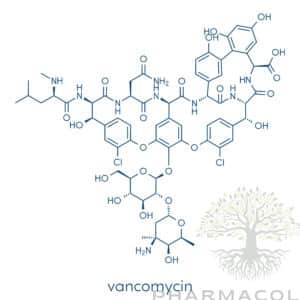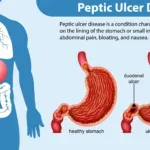Vancomycin is a glycopeptide antibiotic principally used in the treatment of severe infections caused by Gram-positive bacteria, particularly those resistant to beta-lactams such as MRSA (methicillin-resistant Staphylococcus aureus), penicillin-resistant streptococci, and certain enterococci. Its unique action on bacterial cell wall synthesis makes it invaluable for life-threatening infections where other options are ineffective or inappropriate.

#Vancomycin antibiotic drug glycopeptide class molecule Skeletal formula
Mechanism of Action
Vancomycin exerts its bactericidal effect by binding tightly to the D-alanyl-D-alanine termini of the nascent peptidoglycan chains, which are essential precursors in bacterial cell wall biosynthesis. This binding inhibits both transglycosylation and transpeptidation (crosslinking), thus preventing the synthesis and polymerization of N-acetylmuramic acid (NAM) and N-acetylglucosamine (NAG), key components of the peptidoglycan backbone in Gram-positive organisms. The result is inhibition of bacterial cell wall formation, causing osmotic instability, cell lysis, and death. Its large structure and hydrophilicity restrict vancomycin to Gram-positive pathogens, as Gram-negative bacteria possess an outer lipid membrane that prevents vancomycin entry.
Antimicrobial Spectrum
Vancomycin is active exclusively against Gram-positive bacteria, including:
- Staphylococcus aureus (including MRSA)
- Staphylococcus epidermidis (including MRSE)
- Streptococcus pneumoniae (including penicillin-resistant strains)
- Other streptococci (beta-hemolytic, viridans, group B)
- Enterococcus faecalis and faecium (not VRE)
- Corynebacterium, Listeria, Bacillus spp.
- Oral vancomycin is highly effective for Clostridioides difficile infection
Pharmacokinetics
- Absorption: Oral bioavailability is <10%; systemic therapy requires intravenous administration. Oral vancomycin achieves high concentrations in the gut for C. difficile colitis.
- Distribution: Wide distribution in tissues (including pericardial, pleural, synovial, and ascitic fluid); CSF penetration is moderate but improves with meningeal inflammation.
- Protein binding: ~55%
- Metabolism and elimination: Minimally metabolized; 75–90% excreted unchanged by kidneys via glomerular filtration. Half-life is 4–6 hours in healthy adults, much longer in renal impairment.
- Therapeutic monitoring: Trough concentrations (target 10–20 mg/L) and, increasingly, 24-hour AUC/MIC (target 400–600 with MIC ≤1 mg/L) are recommended to ensure efficacy and reduce toxicity.
Indications
- Severe MRSA infections (pneumonia, endocarditis, osteomyelitis, bacteremia)
- Serious penicillin- or cephalosporin-resistant Streptococcus pneumoniae infections
- Enterococcal infections (if susceptible)
- Empiric therapy for sepsis from suspected Gram-positive sources
- Oral use for moderate-severe C. difficile diarrhea/colitis
Dosing
- Adults: 15–20 mg/kg IV every 8–12 hours, adjusted for renal function and infection severity. Loading doses or higher maintenance doses (up to 25–30 mg/kg) may be used in severe/critical illness.
- Pediatrics: Weight-based dosing (10–20 mg/kg/dose IV every 6–12 hours); adjusted based on age/renal function.
- Oral dosing: 125–250 mg every 6 hours for C. difficile colitis.
Adverse Effects
- Nephrotoxicity: Dose-dependent, risk increased with prolonged/high-level exposure, concurrent nephrotoxic drugs (aminoglycosides, amphotericin B, NSAIDs).
- Ototoxicity: Rare; especially at high serum levels, in elderly, with pre-existing hearing loss or concurrent ototoxic drugs.
- Infusion-related reactions: “Red man syndrome” (flushing, erythema, hypotension from rapid infusion). Prevent by infusing over ≥1 hour and premedication with antihistamines if needed.
- Neutropenia, thrombocytopenia: Rare.
- Phlebitis at infusion site.
Resistance
- VISA/VRSA: Some S. aureus strains develop intermediate or full resistance (thickened cell wall or alteration of D-Ala-D-Ala to D-Ala-D-Lac, lowering vancomycin’s binding affinity).
- VRE: Enterococci with resistance genes (vanA/vanB) substitute cell wall precursors so vancomycin cannot bind.
Monitoring
- Renal function (serum creatinine, urine output)
- Trough serum concentrations or AUC-based dosing to optimize therapy and reduce nephrotoxicity risk
- Audiometry with prolonged therapy/ototoxic risk factors
Special Considerations
- Not absorbed orally—thus only IV for systemic therapy, except for GI infections (C. difficile).
- Dose adjust in renal impairment—failure to do so increases toxicity risk.
- Not effective against Gram-negative infections.
References
- Patel S, et al. Vancomycin. StatPearls [Internet]. Treasure Island (FL): StatPearls Publishing; 2024 Oct 28.
- Goodman & Gilman’s The Pharmacological Basis of Therapeutics, 14th ed. New York: McGraw-Hill; 2022.
- Katzung BG, Vanderah TW, eds. Basic & Clinical Pharmacology. 16th ed. New York: McGraw-Hill; 2021.
- DoseMeRx. Vancomycin Mechanism of Action. 2021 Mar 22.
- Medicover Hospitals. How Vancomycin Works: Understanding Its Mechanism. 2025 Jul 30.
📚 AI Pharma Quiz Generator
🎉 Quiz Results
Medical Disclaimer
The medical information on this post is for general educational purposes only and is provided by Pharmacology Mentor. While we strive to keep content current and accurate, Pharmacology Mentor makes no representations or warranties, express or implied, regarding the completeness, accuracy, reliability, suitability, or availability of the post, the website, or any information, products, services, or related graphics for any purpose. This content is not a substitute for professional medical advice, diagnosis, or treatment; always seek the advice of your physician or other qualified health provider with any questions you may have regarding a medical condition and never disregard or delay seeking professional advice because of something you have read here. Reliance on any information provided is solely at your own risk.









